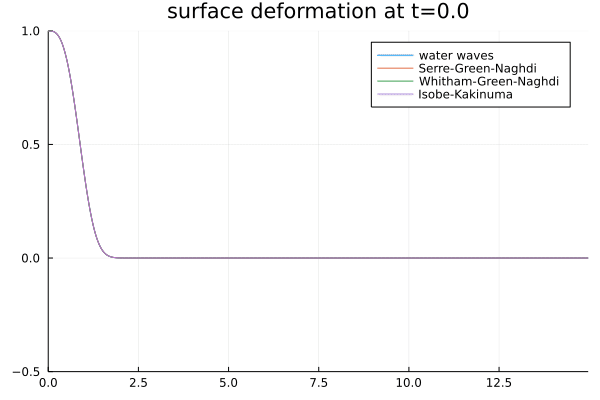Habilitation
Many Model for Water Waves
I defended my Habilitation in July, 2021. The memoir, entitled Many Models for Water Waves, attempts (and obviously fails) at providing a comprehensive overview of several standard and less-standard of models for the propagation of surface gravity waves, interfacial waves or internal waves.
The motivation for preparing this Habilitation was triggered some time ago as I realized that several distinct projects of my own, when pieced together and added to the existing litterature, could provide a somewhat consistent story. It took several years to complete the few “little things” that remained to be settled, and then the incentive of supervising a (second) PhD student to actually put an end to the overambitious project.
The memoir is an effort at unifying the theory on several (classes of) models, and can be thought as building upon the book of David Lannes.1 However there is less emphasize at the water waves system (although the necessary results are quickly recalled), and more at the models derived from it. Its scope is also enlarged as it includes
- “improved” non-hydrostatic models such as the fully dispersive version of the Green-Naghdi system;2
- higher-order models, including
- models for interfacial waves,
- a small take at internal waves for stratified fluids in the hydrostatic framework.
For each of the models, I try to present the state of the art considering their rigorous justification as asymptotic models for water waves : at least their precision in the sense of consistency, and the complete justification when possible. Their Hamiltonian structure and conserved quantities are underlined. A modal analysis and discussion at solitary waves is provided when results are known. Finally, many open questions are put forward.
I also wanted to include a few words on numerical aspects, and specifically the Fourier pseudo-spectral approach (described here) which provides a very efficient way to treat and compare all these systems (in idealized situations) in a unified manner. Together with P. Navaro, we have implemented many of these models in a Julia package: WaterWaves1D.jl.

-
D. Lannes, The water waves problem, volume 188 of Mathematical Surveys and Monographs. American Mathematical Society, Providence, RI, 2013 ↩︎
-
Y. Matsuno, Hamiltonian formulation of the extended Green-Naghdi equations. Phys. D, 301/302:1–7, 2015 ↩︎
-
E. D. Fernández-Nieto, M. Parisot, Y. Penel, and J. Sainte-Marie. A hierarchy of dispersive layer-averaged approximations of Euler equations for free surface flows. Commun. Math. Sci., 16(5):1169–1202, 2018 ↩︎
-
M. Isobe, A proposal on a nonlinear gentle slope wave equation. Proc. Coast. Eng. Jpn. Soc. Civ. Eng., 41:1–5, 1994. [in Japanese]. ↩︎
-
G. Klopman, B. van Groesen, and M. W. Dingemans, A variational approach to Boussinesq modelling of fully nonlinear water waves. J. Fluid Mech., 657:36–63, 2010 ↩︎
-
G. A. Athanassoulis and K. A. Belibassakis, A consistent coupled-mode theory for the propagation of small-amplitude water waves over variable bathymetry regions. J. Fluid Mech., 389:275–301, 1999 ↩︎
-
W. Choi and R. Camassa, Weakly nonlinear internal waves in a two-fluid system. J. Fluid Mech., 313:83–103, 1996 ↩︎
-
T. Kakinuma, A set of fully nonlinear equations for surface and internal gravity waves. In Coastal Engineering V: Computer Modelling of Seas and Coastal Regions, 225–234, 2001 ↩︎